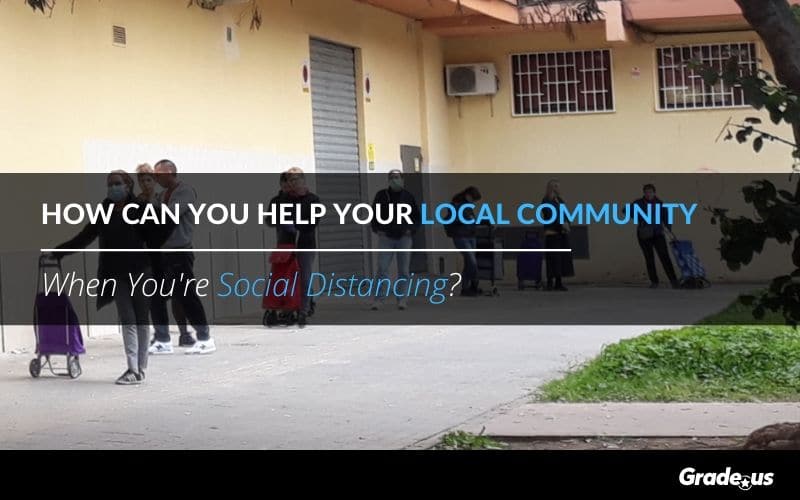We’re all in isolation, but that doesn’t mean you can’t help your local community.
We’ve been asked by our governments to follow social distancing guidelines.
While it’s something many of us are already following, it’s difficult to know how we can go about helping others during this self-quarantine period. We’re seeing beautiful examples of individuals helping others in their community.
What about your business?
How can you help your local community as a business?
Before we can go about helping others, we need to get a clear understanding of social distancing — what it means and how it impacts your business.
Here’s how Wikipedia defines it:
“Social distancing, or physical distancing, is a set of infection control actions intended to stop or slow down the spread of a contagious disease. The objective of social distancing is to reduce the probability of contact between persons carrying an infection, and others who are not infected, so as to minimize disease transmission, morbidity and ultimately mortality.”
It’s self-explanatory, right?
We’re basically being asked by local authorities to do this…
Which will produce these results:

Source: thespinoff.co.nz
This complicates things a bit.
As a business, it’s a tough call to make. How exactly do you go about helping your local community under these guidelines? As it turns out, that’s the easy part. What’s not so easy is defining why you should go out of your way to help your local community.
There are lots of reasons.
- You care about the people in your community
- You feel a calling to take care of those around you who need help
- You're interested in the positive business and brand-building benefits that come with helping others
- Serving your community serves your interests
- Helping your community decreases recovery time
It’s up to you.
Why though? Why go out of your way to find a reason to help others? The more we help each other, the sooner things return to normal.
There’s a bigger reason.
The more we help each other, the faster our recovery, and the less likely we are to experience a recession. As I shared in my previous post, the historical evidence shows we’ve been able to bounce back in weeks or months. Serving others produces intangible benefits (trust, honor, loyalty, etc.) that are far more valuable than revenue.
What you'll need to do before you help your local community
There are several ways to help your local community. The amount of help you’re able to contribute will depend on the type of business you’re running, your specific circumstances, and the burn rate you’re working with.
1. Type of business: contact-dependent businesses — retain, restaurants, bars, beauty, home care, events, and wedding industries — are more affected by social distancing guidelines than say, law firms, accountants, or marketing agencies.
2. Specifics of circumstance: Is your business seasonal? Are you in the middle of an expansion? Have you recently taken on more employees? Are your customers negatively affected by the quarantine? Your circumstances will determine what responsible giving looks like for your business.
3. Burn rate: Your burn rate is the rate of negative cash flow, reflected as a monthly rate. Your burn rate determines how long you can survive on the cash you have saved. If your company has $1 million in the bank and you spend $100,000 per month, your burn rate is 10 months ($1,000,000 savings) / ($100,000 monthly expenses) = 10 month burn rate
It’s a good idea to keep these factors in mind; when helping, the priority should be first stabilizing your circumstances then, helping others. Your business is no good to the community if it’s bankrupt. You’ll want to use the above criteria to answer four critical questions.
- Who will you help? The question of who depends primarily on why you're giving and the type of business you're in. For example, if you're a salon that offers manicures and pedicures, you may choose to help women in your community. If you're a real estate attorney, you may focus your attention on your clients exclusively or homeowners in your community.
- What can you do to help? You can't give what you don't have. I'll provide you with an easy framework you can use to determine what you can do to help. This framework is something you should use to assess what you can contribute at a moment's notice.
- How much can you help? This question measures how much you can help others at any given moment via your time, resources, or connections. The degree of help you can provide can be static or dynamic. It can be mixed (e.g., you offer your time one week, resources the next) in any way you see fit.
- How long can you help? What sort of giving will you engage in? One-time giving or repeated and ongoing support? Will you continue to help once everyone receives the all-clear? A specific time during the quarantine? Or for a set period of time.
This doesn’t need to be complicated either.
It just needs to be something that you think of ahead of time, so you’re able to take good care of those under your care and those you choose to serve.
How to help your local community
The upfront work you’ve done so far will make it easy for you to determine how you’ll go about serving your community.
Now it’s time to put all of this together.
Let’s look at a few fictitious scenarios to see how we can come up with a viable plan to add value to our communities.
See what I did there?
I created a simple, seven-question framework you can use to determine the specifics of how you’ll help your local community and what you’re able to provide comfortably.
It’s not complicated.
Now we’ll need to address the types of help you can provide. This is also relatively simple. When it comes to helping, you can offer your community your:
- Time in the form of volunteering. This could be volunteering your time to serve those in need directly or indirectly. You can volunteer your time in-person, remotely or on a contingent basis.
Here’s an example. Pacific Community Ventures is calling for remote volunteers, specifically those with expertise in finance, HR, marketing, and other areas to help small businesses that are impacted by COVID-19.
How to help: If you’re willing to share your time, you can become a remote volunteer via specific platforms. You can help businesses, employees, and the unemployed to recover during the pandemic. You can use platforms like The American Red Cross, United Way, BusinessAdvising.org or VolunteerMatch.org to identify remote volunteering opportunities. You can do a Google search for volunteering opportunities. Choose three organizations in need, then reach out to them directly. You can search for national, regional, state or community organizations.
Here’s a template you can use to reach out.
Hi [organization],
My business would like to help right now. We live in the area and with the current social distancing laws in place, we’d like to know what’s the best way that we can contribute?
Best,
[Your name]
- Connections to key influencers and points of contact. There's a shortage of toiletries and cleaning products in certain metro areas. If you have a connection to a manufacturer who can get these supplies to the right people, this connection would be valuable.
Here’s an example of former Obama health care lead, Andy Slavitt using his influence to advocate for others.
DENTISTS/PAINTERS/CONTRACTORS/PLASTIC SURGEONS: Please— if you have any protective gear, N-95 masks or other, gloves, thermometers sitting around, bring them to your local hospitals. In any number. All you have.
— Andy Slavitt @ 🏡 (@ASlavitt) March 20, 2020
Let us know what you’ve done! Please consider circulating this.
How to help: Now is the time to call in favors and use your connections to get things done. Here’s the thing about using your connections, if it’s done to serve others your influencing power and weak connections grow exponentially via the The 5 + 50 + 100 rule. Use connections for yourself exclusively and your influencing power decreases.
- Resources to in-demand items. This includes straightforward resources like money, which you can use to donate to those who are in need. But it also includes hard-to-purchase resources (e.g., toilet paper, supplies, sanitary masks, etc.).
Here’s an example of several Cambridge restaurants — Pinocchio’s Pizza, Orinoco, and Zinneken’s partnering with Eater.com to deliver meals to homeless shelters with a goal of delivering 2,000 meals to nine shelters by the end of the week.
How to help: Give what you have, if you can spare it. If you’re an agency, give your time and expertise. If you’re a restaurant, feed those who need food and work to accommodate customers. If you’re a home improvement professional, show customers how to make small improvements around the home on their own.
- Information that provides people with much-needed data. How businesses can qualify for, and receive grants or loans to keep their businesses afloat. Do you know how to help employees apply for their share of cash disbursements and unemployment benefits? Maybe you can help people make better use of the less-than-adequate resources they have to work with.
Here’s an example of ClearView Tax Accountants discussing the details of the Covid-19 Stimulus Package Forgivable Small Business Loans.
How to help: If you’re an agency, you can provide your clients with any information they can use to keep their business afloat. This includes, alternative funding options, emergency loans and assistance, offers to motivate customers to continue to buy, etc.
- Abilities that allow you to do what others can't. Are you a talented negotiator who can get difficult deals done? Maybe you're a capable salesman who can persuade manufacturers to divert needed resources to your community?
Here’s an example of an app created by developers for Feeding San Diego. Their MealConnect app allows restaurants to contact the nonprofit whenever they have surplus food to donate. Volunteers will pick up the food and deliver it directly to local groups, avoiding trips to the warehouse.
How to help: Think about the skills, expertise, and abilities you have that you can use to serve your community right now. If you’re a professional, you already have a specific set of skills and resources you can use to help. FInd a problem that needs to be solved, then approach those who need help and get to work. It’s really that simple.
Figure out what you’re willing to give.
Determine the right mix of assistance you’re willing to contribute so your business remains stable while also providing much-needed support to your community.
Social distancing can't stop those eager to help their community
COVID-19 won’t stop those who are eager to help.
These social distancing guidelines are difficult for many, but it’s a chance for you to serve your community. It’s an opportunity you can use to grow, even as we’re facing these temporary restrictions.
Become a fixer.
Find the problems your community needs solved right now, then implement a plan of action to solve those problems. Strike out on your own or partner up with like-minded entrepreneurs in your community who are interested in helping.
This is part of your story now.
Here’s your chance to make an impact in your community.










